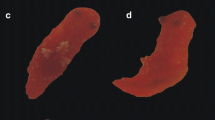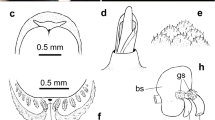Abstract
A new Antarctic species belonging to the genus Didemnum is described. The material was collected during the BENTART-03 cruise through the Bellingshausen Sea. The geographic and bathymetric distribution of the known Didemnum species from Antarctic and Subantarctic regions and a tabular key for the identification of these species are summarized.
Similar content being viewed by others
Avoid common mistakes on your manuscript.
Introduction
The Bellingshausen Sea, although being one of the three great frozen seas of Antarctica (the other two being the Ross and the Weddell Seas), is largely inaccessible and remains undersampled; its benthic communities have still not been completely investigated.
The “Belgica” Expedition (1897–1899) collected the first few specimens from this sea. Only 12 species of ascidians have been reported from this area (Monniot and Monniot 1983) plus four new records (Varela 2007), in a total of 58 species in the Antarctic continent (Ramos-Esplá et al. 2005).
The ascidians of the Bellingshausen Sea and Peter I Island were studied as part of the BENTART-03 Programme carried out from January to March 2003, on the shelf of Bellingshausen Sea, Peter I Island, and the Antarctic Peninsula.
The main objective of the survey was the study of benthic ecosystem biodiversity in these zones, attempting to integrate data of all different benthic compartments with the environmental conditions.
After we studied the ascidians collected (Ramos-Esplá et al. 2005), we found some colonies that could not be assigned to any known Didemnum species. They are described below as Didemnum bentarti sp. nov.
Materials and methods
The Spanish Antarctic expedition “BENTART-03” was undertaken during the austral summer 2002–2003. Indirect sampling was carried out for quantification of the benthos. A total of 25 stations (Margarite Harbor to Thurston Island) were sampled up (Fig. 1).
Ascidians were collected by Agassiz trawl, at depths from 46 to 2,043 m (Ramos and Moya 2003). Collected ascidians were placed in seawater with menthol for relaxation for several hours prior to fixation in buffered formaldehyde 5% in seawater. Animals were analyzed under binocular microscope at the Department of Marine Science and Applied Biology, Universidad de Alicante, Spain.
One colony designated as holotype was deposited in the Museo Nacional de Ciencias Naturales (MNCN), Madrid; the registration number is indicated by MNCN Reg. and a number. A second colony, designated as paratype, was deposited at the Department of Marine Science and Applied Biology, Universidad de Alicante, Spain.
Results and discussion
Species description
Family DIDEMNIDAE Giard, 1872
Genus Didemnum Savigny, 1816
Didemnum bentarti sp. nov. (Figs. 2, 3, 4, 5).
Material examined
B03/4A (material type) two colonies: Holotype MNCN Reg. 31.01/79. Sta. 04A, 02-02-2003, 70°51′96″S; 98°26′29″W (Thurston Island-Amundsen/Bellingshausen Sea), 426 m (Fig. 1).
Etymology
The specific name bentarti has been taken from BENTART, the Spanish team of Antarctic benthic research.
Diagnosis
Encrusting colonies. The tunic is thin, with an average thickness of 2 mm. Spicules are unique, rounded in shape with short rays evenly distributed. The lateral thoracic organs on each side are situated at the level of the first row of stigmata. The testis is undivided: the vas deferens describes three to four spiral turns around it.
Description
Colony
Encrusting irregular colonies adhere to small rocks. The tunic is very thin, with a smooth surface. The maximum length is 3 cm and average thickness 2 mm. The test is transparent but shows white color because of the spicules, which are dense throughout the test and around the zooids, leaving a hollow in which the zooid is located. The spicules, up to 0.04 mm in diameter, have a spherical shape; small short rays project uniformly from the body, in number from about 25 to 30 in optical section per spicule (Figs. 2, 3). Cloacal systems are not apparent.
Zooids
The zooids are small, reaching a total length of about 1.4 mm. The branchial aperture is six-lobed. The atrial opening is wide: its aperture exposing most of the thorax and fully extending the upper border may form a small lip. The branchial sac has four rows of 12 narrow stigmata, six per side. The lateral thoracic organs on each side are situated at the level of the first row of stigmata (Fig. 4).
The abdomen is smaller than the thorax. The stomach is smooth and rounded. The testis is undivided and the vas deferens makes three or four spiral turns around it (Fig. 5). The ovary is located in the intestinal loop.
Ecology and distribution
Didemnum bentarti sp. nov. seems to be a slope species, it was found at 426 m. Its geographical distribution is restricted to the west side of Antarctica, at the Bellingshausen Sea, where it was found (70°51′96″S; 98°26′29″W) (Fig. 1; Table 1).
Remarks
This species has some features that differentiate it from other Didemnum species (Table 2).
The shape, length and distribution of spicules, are characteristic and very different from other Didemnum species. The combination of spicule shape, ray length and distribution are unique.
Didemnum biglans has stellate spicules in a semitransparent tunic, disposed in white masses in the surface layer but absent or sparse in the inner test (Kott 1969; Monniot and Monniot 1983). Other differences include 4–5 stigmata per side and usually a bilobed testis.
Didemnum studeri has a multilobed testis and stellate spicules with about 8–12 short blunt rays in optical section. Spicules are often more sparsely distributed; however, they may be dense (Kott 1969; Monniot and Monniot 1983).
The species D. tenue has stellate and spicules, up to 0.03 mm, but 9–10 spirals of the sperm duct (Kott 1969; Monniot and Monniot 1983). Also, D. tenue has the thoracic organs in the posterior part of the thorax and there are 3–4 stigmata per half row.
Didemnum subflavum has spicules, which exhibited an irregular form: discoid (similar to Cystodytes), ellipsoidal, lobed or stellate. Spicules attain up to 0.03 mm in diameter. This species has specific thoracic organs with ear form. There are 3–4 stigmata per half row and the testis is divided. The vas deferens coils nine times (Herdman 1886; Vasseur 1974).
Some geographic and bathymetric considerations
Although there are now five known species of Didemnum from the Antarctic and Subantarctic regions, none is distributed in both regions. The new species D. bentarti has at the moment a restricted distribution in Bellingshausen Sea (Fig. 1). D. biglans is an Antarctic endemism too, but its distribution is wider, being circumantarctic including the Scotia Ridge (Kott 1969; Monniot and Monniot 1983; Ramos-Esplá et al. 2005).
The other three species have never been found in Antarctica: D. subflavum is subantarctic distributed in Kerguelen Islands (Vasseur 1974) and Magellan area (Monniot and Monniot 1983); D. tenue has been found at Magellan area, South Georgia (Monniot and Monniot 1983) and New Zealand (Kott 1969); D. studeri has a wide distribution in Subantarctic islands, along Magellan, Scotia Ridge (Ramos-Esplá et al. 2005), Tasmania, South New Zealand Region and Tristan da Cunha (Primo 2006).
As shown in Table 1, most of the Antarctic and Subantarctic species of Didemnum have a wide bathymetric distribution; only D. subflavum has a shallow distribution, up to 100-m depth (Vasseur 1974, Monniot and Monniot 1983).
Tabular Key to the Antarctic and Subantarctic species of Didemnum (Table 2).
-
1.
Spicules’ shape:
-
S. Stellate.
-
O. Spherical.
-
I. Irregular.
-
-
2.
Number of stigmata in each half row: 1,…n.
-
3.
Position of thoracic organs:
-
A. Anterior of the thorax.
-
M. Middle of the thorax.
-
P. Posterior of the thorax.
-
-
4.
Number of testes: 1,2,3.
-
5.
Number of vas deferens coils: 2…n.
-
6.
Other features.
References
Hartmeyer R (1911) Die Ascidien der deutchen Südpolar-Expedition 1901–1903. Dtsch Südpol Exped 12(4):225–392
Herdman WA (1886) Report on the Tunicata collected during the Voyage of H.S.M. Challenger during the years 1873–1876. Part II. Ascidiaea Compositae. Report of the Scientific Results of the Voyage of H.M.S. Challenger during the years 1873–1876, 14(38):1–399
Kott P (1969) Antarctic Ascidiacea. Antarct Res Ser 13:1–239
Monniot C, Monniot F (1983) Ascidies Antarctiques et Subantarctiques: Morphologie et Biogéographie. Mémo du Muséum Nat d’Hist Nat Paris (A) 125:1–168
Primo C (2006) Taxonomía y Biogeografía de la Clase Ascidiacea en las regiones Antártica y Subantártica. Ph.D. thesis, University of Vigo
Ramos A, Moya F (2003) Informe de la campaña Bentart-03. In: Proceedings of the Inf. Int. Inst. Esp. Oceanogr, Málaga, 189pp
Ramos-Esplá AA, Cárcel JA, Varela M (2005) Zoogeographical relationships of the litoral ascidiofauna around the antarctic Península, in the Scotia Arc and in the Magellan region. Sci Mar 63(Suppl 2):215–223
Sluiter CP (1906) Tuniciers. In: Masson (ed) Expedition Antartique Française 1903–1905. Paris, pp 1–48
Varela MM (2007) Contribución al conocimiento de las ascidias coloniales (Chordata: Tunicata) de la Antártida Occidental y Región Magallánica. Ph.D. thesis, University of Alicante
Vasseur P (1974) Ascidies des iles Kerguelen recoltées par J.C. Hureau. Tethys 5:735–746
Acknowledgments
The authors are grateful to Ana Ramos, the responsible scientists of the cruise, Ignacio Olaso and Marcos Tatián for their help and comments. The work was carried out under a research fellowship from the Ministerio de Educación y Ciencia, Spain.
Author information
Authors and Affiliations
Corresponding author
Rights and permissions
About this article
Cite this article
Varela, M.M., Ramos-Esplá, A. Didemnum bentarti (Chordata: Tunicata) a new species from the Bellingshausen Sea, Antarctica. Polar Biol 31, 209–213 (2008). https://doi.org/10.1007/s00300-007-0348-1
Received:
Revised:
Accepted:
Published:
Issue Date:
DOI: https://doi.org/10.1007/s00300-007-0348-1









